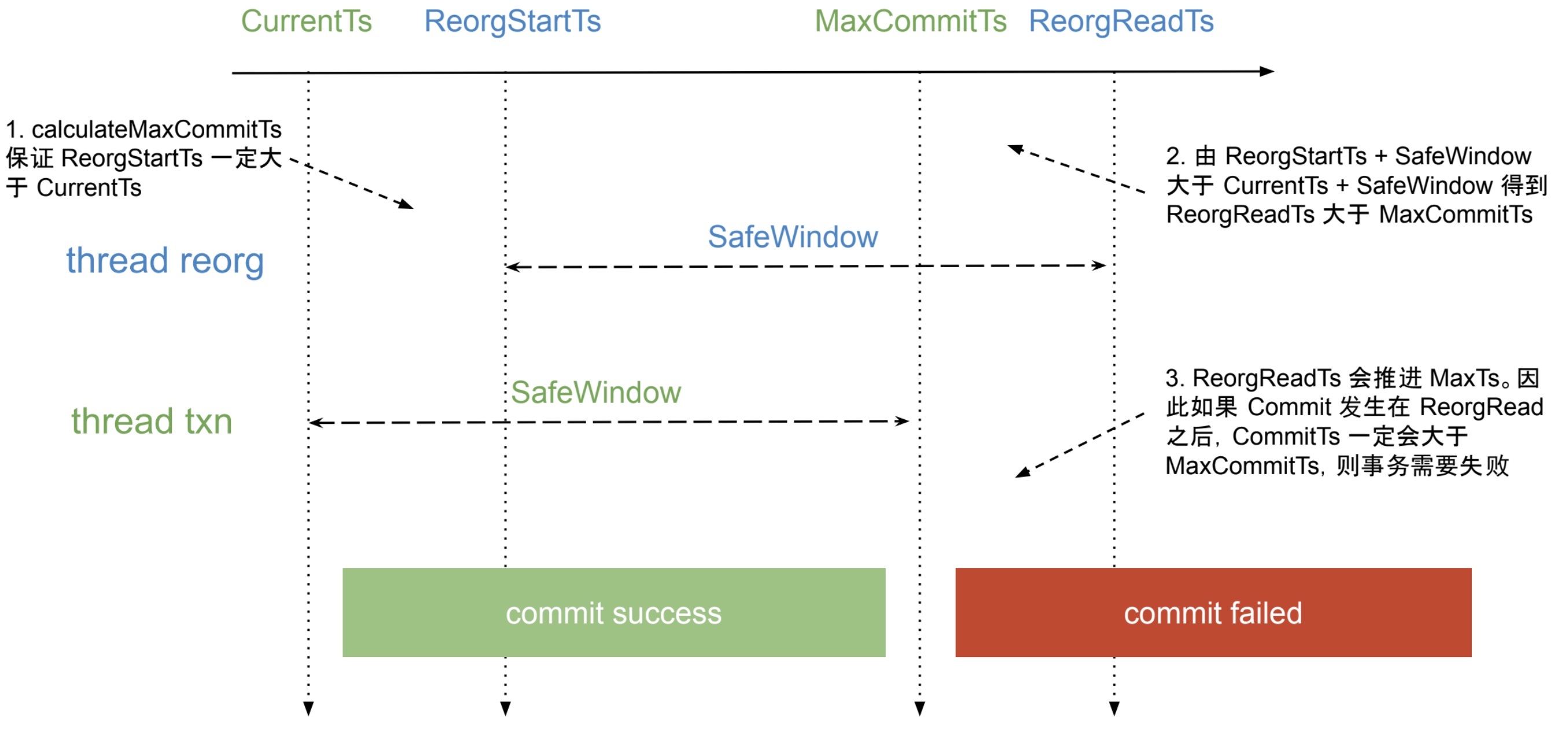[笔记] TiDB 的 Schema 版本检查
这篇笔记主要记录 tidb 在 online schema change 实现中遇到的索引数据不一致问题,以及如何在同步提交和异步提交下通过检查 schema 版本避免该问题。
Online Schema Change
参考论文 Online, Asynchronous Schema Change in F1,本文就不详细介绍了。
算法的核心主要有两点:
- 将一次 schema 变更拆解为多个中间状态(论文中的 delete-only、write-only 和 tidb 实现中的 reorg),保证相邻的两个状态相互兼容(不会导致数据遗漏、残留或是错误)
- 通过 lease 确保了在分布式系统中所有节点同一时间最多只会有两个相邻的 schema 版本生效
实际的工程问题
tidb 按照论文中的要求实现了 schema lease,保证所有 tidb 节点中同时只存在两个相邻的 schema 版本,但仍然会遇到一些问题。
在分布式事务下,「数据组装和写入」以及「数据提交和可见」是两个不同的时间点,而 schema lease 只能保证某一个时间点下的 schema 版本。所以当数据提交时,schema lease 所保护的 schema 版本可能已经不是写入时的版本了,那就破坏了论文中的保证。
以加索引为例,在这里举两个实际的例子。
加索引的状态变更流程为:
1 | Absent => Delete Only => Write Only => Reorg => Public |
考虑以下时序一:
- 此时 lease 处于 Delete Only 状态
- 事务 A 创建,并写入一行记录,事务处于 Delete Only 状态,所以不会写入创建中的索引行
- lease 推进到 Write Only 状态
- lease 推进到 Reorg 状态
- Reorg 补全存量数据的索引时,因为事务 A 还没有提交,所以无法扫描到其对应的记录行,也就不会补全对应的索引
- Reorg 完成,lease 推进到 Public 状态
- 事务 A 提交,此时数据可见但缺少了索引记录,产生了数据不一致
考虑以下时序二:
- 此时 lease 处于 Absent 状态
- 事务 A 创建,获取 schema 版本为 Absent
- lease 推进到 Delete Only 状态
- lease 推进到 Write Only 状态
- 事务 B 创建,获取 schema 版本为 Write Only
- 事务 B 更新某一行并提交,事务处于 Write Only 状态,所以会写入索引行
- 事务 A 删除同一行并提交,事务处于 Absent 状态,所以不会删除索引行,此时出现了索引数据残留,产生了数据不一致
可以发现,这两个时序都是在 schema lease 推进 schema 版本到 N+1 后,事务提交了 schema 版本为 N-1 的数据。
同步提交下的解决方案
对于同步提交,tidb 通过在 2pc 时进一步检查 schema 版本避免该问题。
具体的时机是在 prewrite 成功且获取 commit ts 之后进行检查,如果当前通过 schema lease 获取的 schema 版本和事务创建时的版本相同,说明全局的 schema 版本最多只有可能推进一个版本,便仍然是可兼容的版本,此时便可以继续 commit,否则本次 2pc 需要失败并重试。
实际检查会更精细一些,包括推进的 schema 版本是否和本次操作的表有关系,不过这些不在本文的核心内容中,就不详述了。
Async Commit
上面说完了同步提交,再说说 tidb 5.0 实现的异步提交,同样仅简述一些必要的背景知识。具体可以参考官方博客中的介绍或是分布式事务的时间戳这篇文章。
从流程上来看,同步提交和异步提交的区别为:
- 同步提交下,tidb 需要在 prewrite、获取 commit ts 以及 commit primary 之后才能返回客户端结果,响应前需要 3 次 rpc 和 2 次写日志的延迟
- 而在异步提交下,tidb 在获取 min commit ts 以及 prewrite 之后便可以返回客户端结果,响应前只需要 2 次 rpc 和 1 次写日志的延迟
从正确性来看,异步提交的核心实现是 commit ts 由 prewrite 阶段动态计算得出,也就是 commit 的结果和「定序」均在 prewrite 时已经确定并持久化,之后便不可以再更改。
异步提交下的问题
异步提交的实现在 prewrite 完成后便将结果返回给了客户端,而回复就意味着承诺,也就表示之后的结果一定不能改变。
如果还采用同步提交的方案,在 commit 之前才检查 schema 版本,那么就会出现已经返回成功后,检查 schema 版本却失败了的问题,此时违背了之前的承诺。
看到此处读者可能会想,那在 prewrite 成功返回结果之前就检查 schema 版本,如果检查失败就直接返回失败,不再走 commit 流程,是否就能解决这个问题了。
很遗憾,答案还是不能,考虑一下极端情况,tidb 节点完成检查 schema 版本后返回成功,但是在发起 commit 之前宕机了。之后的恢复流程需要再次检查 schema 版本(因为不知道是检查前宕机还是检查后宕机),此时有可能检查 schema 版本失败并回滚,同样违背了之前的承诺。
异步提交下的解决方案(一)
考虑一下,为什么第一次检查 schema 版本成功后,第二次检查 schema 版本会失败呢?
因为同步提交下的 schema 版本检查实际是一个「单向屏障」,在获取 commit ts 之后获取最新的 schema 版本并检查,只能做单向保证:「通过检查表示该 commit ts 一定符合要求」,而不是「符合要求的 commit ts 都能通过检查」。因为获取 commit ts 和获取最新的 schema 版本中间会有缝隙,检查失败不一定不符合要求。
因此,即使 commit ts 不变,随着时间的推移,schema 检查会逐渐趋向于失败,而此时的失败就是被误判的场景。
那么是否有办法将这个检查变为一个「双向屏障」,即保证 commit ts 和 schema 版本一定是一一对应的,只要 commit ts 不变,对应的 schema 版本也就不会变,那么检查 schema 版本也会变为确定的结果。
在此介绍 tidb 的第一版解决方案,主要的工作在 txn: add schema version check for async commit recovery #20186 下。
其核心改动是增加了 checkSchemaVersionForAsyncCommit 函数,实现异步提交下的 schema 版本检查,代码如下:
1 | // checkSchemaVersionForAsyncCommit is used to check schema version change for async commit transactions |
这个实现使用了 start ts 和 commit ts 进行快照读获取当时的 schema 版本,这样当 commit ts 确定时(异步提交在 prewrite 完成后即确定 commit ts,并且在故障恢复时也可以通过持久化的数据计算出相同的值),schema 版本也是确定的,不受真正提交和检查 schema 版本时机的影响。
不过这个方案的缺点也很明显,在检查 schema 版本时需要进行两次快照读(理论上可以合并为一次),在主路径上增加 rpc 的开销并不小,可能会影响到异步提交带来的性能提升,因此这个方案也没能成为最终方案。
异步提交下的解决方案(二)
鉴于方案一有一些不完美的地方,tidb 在 ddl, tikv: add delay during AddIndex DDL and remove schema check for async commit #20550 中又实现了一个新的方案,并沿用至今。
主要实现是增加了 calculateMaxCommitTS 函数,用于在 prewrite 前计算一个确定合法的 commit ts 上界,代码如下:
1 | func (c *twoPhaseCommitter) calculateMaxCommitTS(ctx context.Context) error { |
首先对当前时间生成一个当前时间的 tso(在 start ts 的基础上偏移事务创建时间),如果当前时间通过了 schema 版本检查,就在当前时间的基础上增加 2s(safe window)作为 max commit ts。之后在 prewrite 计算 commit ts 时,如果计算出的 commit ts 超过了 max commit ts,则返回失败。
除此之外,在执行 reorg 时也需要等待 2.5s(2s 的 safe window + 0.5s 的时钟漂移) 才能真正开始:
1 | func (w *worker) runReorgJob(t *meta.Meta, reorgInfo *reorgInfo, tblInfo *model.TableInfo, lease time.Duration, f func() error) error { |
异步提交 schema 版本检查的正确性
我不太清楚该如何系统性的描述整个方案的正确性,因此下面的内容是以 Q&A 的方式进行记录。
以下部分疑惑请教了上述 PR 的原作者 @sticnarf,感谢他的解答。
Q:SafeWindow = 2s 是否有特殊含义,还是只是一个经验值?
最开始我以为设置的 2s 是依赖了 schema lease 的实现,即每个操作都会等 2 * leasa 的时间。后来想到 tidb 支持在 pd 上注册和监听 schema 版本变更以加速推进 ddl,实际并没有这个保证(并且 lease time 是可配的,肯定不会在代码里写死 2s)。
所以这应该是一个经验值,认为异步提交的事务在 prewrite 阶段基本都会在 2s 内完成,并且代码中动态计算了 current ts 而不是直接用 start ts 也是为了尽量减少事务时间的限制,对长事务更加友好。
Q:为什么 reorg 需要等待 SafeWindow(不考虑时钟漂移的情况下)?
在异步提交下 reorg 出现问题的时序是确定的:
- 一个 delete-only 的事务完成 preprocess,准备提交
- 事务计算出 current ts
- current ts 通过 schema 版本检查
- 计算 max commit ts = current ts + 2s
- reorg 获取 reorg read ts 进行扫描(此时还没有 prewrite 完成,否则会走读等待逻辑)
- 事务发起 prewrite,此时需要使用 max commit ts 进行拦截
根据异步提交的实现,reorg 扫描时会将 tikv 对应的 max ts 推进到 reorg read ts,而之后 prewrite 时事务 commit ts 的计算区间即为 [reorg read ts, max commit ts),此时如果需要拦截住所有事务提交,就需要让 max commit ts 小于等于 reorg read ts。
而从上面的时序中可以得到 reorg read ts 一定大于 current ts,那么 reorg read ts + 2s 则一定大于 max commit ts,基于此使得 reorg 在执行前也需要等待 2s。

注意上述的前提都是不考虑时钟漂移的情况下。
Q:为什么 reorg 需要额外等待时钟漂移?
有两处地方会受到始终漂移的影响:
- 计算 current ts 时使用了当前时间和 start time 的差值,如果 sql 发生时钟漂移会导致这个值可能比预期更大,也就会使 max commit ts 比预期更大
- 请教 @sticnarf 后得知,如果 pd 发生了时钟漂移可能会导致 reorg 时获取的 reorg read ts 比预期更小
只要发生了上述任意一种场景,都会导致 max commit ts < reorg read ts 这个保证不成立,也就有可能导致索引丢失。
所以,依赖 tso 和现实时间进行“绑定”是一个有风险的行为,例如:从 pd 拿到一个 tso A,在其基础上增加 2s 得到 A’,然后在本地 sleep 2.1s 后从 pd 在拿到 tso B,此时无法保证 B 一定比 A’ 更大。
Q:为什么只有 reorg 需要等待,而其他阶段(比如 write-only)不需要等待
在本文的最开始介绍了发生错误的两个时序,在不同方案中检测出问题的时机也是不同的:
- 在同步提交的逻辑下,这两个时序皆是在 commit 前获取当前的 schema 版本并检查出来,没有什么区别
- 而在异步提交下,因为有行锁的保护,同一行的写入和提交一定是串行化的,那么时序 2 在
calculateMaxCommitTS时就能检查出来(因为两个事务都是写操作),只有时序一才需要通过 reorg 的等待进行保证(因为 reorg 是读操作)
总结
- tidb 的 online schema change 实现,需要在事务提交阶段额外检查 schema 版本以保证数据正确性
- 在同步提交的实现中,仅需要在 2pc commit 前进行 schema 版本校验即可避免所有问题
- 在异步提交的实现中,需要在 2pc prewrite 前计算出一个 max commit ts,并在 reorg 时额外等待一个安全窗口,才能避免索引缺失的问题
- 即便如此,在极端场景下(产生非常大的时钟漂移时),异步提交的实现仍有可能出现问题